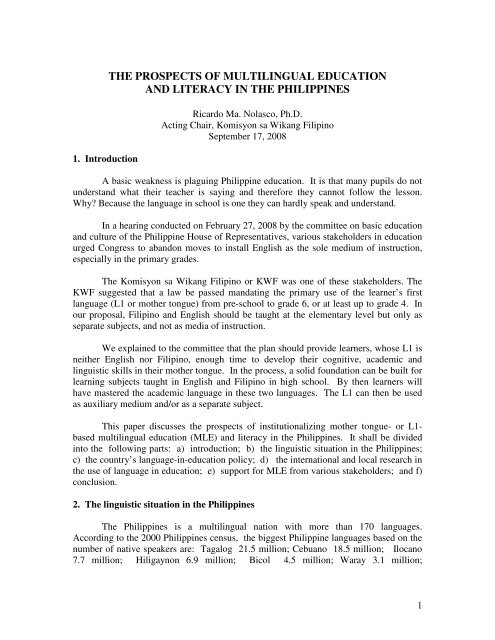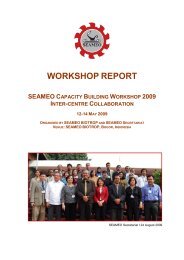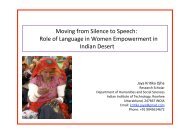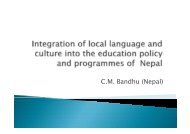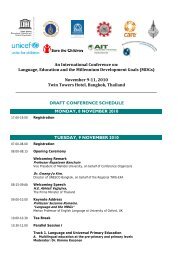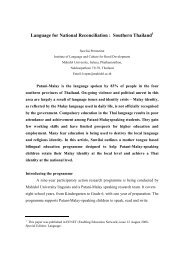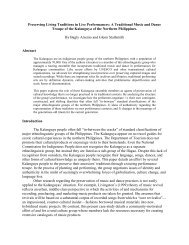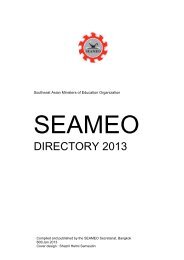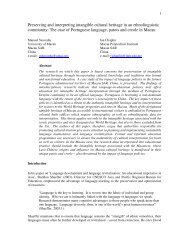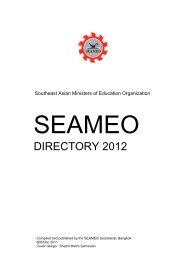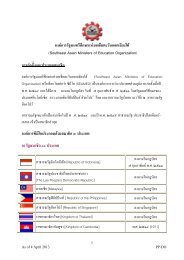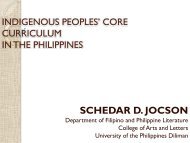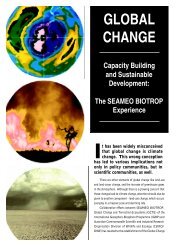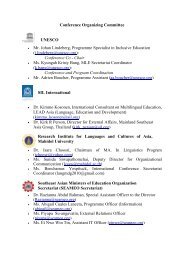THE PROSPECTS OF MULTILINGUAL EDUCATION ... - SEAMEO
THE PROSPECTS OF MULTILINGUAL EDUCATION ... - SEAMEO
THE PROSPECTS OF MULTILINGUAL EDUCATION ... - SEAMEO
Create successful ePaper yourself
Turn your PDF publications into a flip-book with our unique Google optimized e-Paper software.
1. Introduction<br />
<strong>THE</strong> <strong>PROSPECTS</strong> <strong>OF</strong> <strong>MULTILINGUAL</strong> <strong>EDUCATION</strong><br />
AND LITERACY IN <strong>THE</strong> PHILIPPINES<br />
Ricardo Ma. Nolasco, Ph.D.<br />
Acting Chair, Komisyon sa Wikang Filipino<br />
September 17, 2008<br />
A basic weakness is plaguing Philippine education. It is that many pupils do not<br />
understand what their teacher is saying and therefore they cannot follow the lesson.<br />
Why? Because the language in school is one they can hardly speak and understand.<br />
In a hearing conducted on February 27, 2008 by the committee on basic education<br />
and culture of the Philippine House of Representatives, various stakeholders in education<br />
urged Congress to abandon moves to install English as the sole medium of instruction,<br />
especially in the primary grades.<br />
The Komisyon sa Wikang Filipino or KWF was one of these stakeholders. The<br />
KWF suggested that a law be passed mandating the primary use of the learner’s first<br />
language (L1 or mother tongue) from pre-school to grade 6, or at least up to grade 4. In<br />
our proposal, Filipino and English should be taught at the elementary level but only as<br />
separate subjects, and not as media of instruction.<br />
We explained to the committee that the plan should provide learners, whose L1 is<br />
neither English nor Filipino, enough time to develop their cognitive, academic and<br />
linguistic skills in their mother tongue. In the process, a solid foundation can be built for<br />
learning subjects taught in English and Filipino in high school. By then learners will<br />
have mastered the academic language in these two languages. The L1 can then be used<br />
as auxiliary medium and/or as a separate subject.<br />
This paper discusses the prospects of institutionalizing mother tongue- or L1-<br />
based multilingual education (MLE) and literacy in the Philippines. It shall be divided<br />
into the following parts: a) introduction; b) the linguistic situation in the Philippines;<br />
c) the country’s language-in-education policy; d) the international and local research in<br />
the use of language in education; e) support for MLE from various stakeholders; and f)<br />
conclusion.<br />
2. The linguistic situation in the Philippines<br />
The Philippines is a multilingual nation with more than 170 languages.<br />
According to the 2000 Philippines census, the biggest Philippine languages based on the<br />
number of native speakers are: Tagalog 21.5 million; Cebuano 18.5 million; Ilocano<br />
7.7 million; Hiligaynon 6.9 million; Bicol 4.5 million; Waray 3.1 million;<br />
1
Kapampangan 2.3 million; Pangasinan 1.5 million; Kinaray-a 1.3 million; Tausug 1<br />
million; Meranao 1 million; and Maguindanao 1 million.<br />
While it is true that no language enjoys a majority advantage in our country, the<br />
census shows that 65 million out of the 76 million Filipinos are able to speak the national<br />
language as a first or second language. Aside from the national lingua franca, regional<br />
lingua francas, like Ilokano, Cebuano and Hiligaynon are also widely spoken.<br />
English is also a second language or L2 to most Filipinos. According to the<br />
Social Weather Stations, in 2008, about three fourths of Filipino adults (76%) said they<br />
could understand spoken English; another 75% said they could read English; three out of<br />
five (61%) said they could write English; close to half (46%) said they could speak<br />
English; about two fifths (38%) said they could think in English; while 8% said they<br />
were not competent in any way when it comes to the English language.<br />
The self-assessment of Filipinos to speak and write in English and in Filipino may<br />
not be consistent with their actual proficiency in those languages.<br />
For instance, in 1998, Guzman and her team administered proficiency tests to<br />
five separate groups in Metro Manila. The groups consisted of: a) University of the<br />
Philippines undergraduate students (UP-U); b) UP law students (UP-L); c)<br />
undergraduate students from a sectarian university (SU); d) undergraduate students<br />
from a private non-sectarian university (PNSU); and e) employees in a workplace (WP).<br />
Test items were selected on the basis of learning competencies and skills expected of<br />
high school graduates as determined by the Department of Education. The results were<br />
as follows:<br />
Table 1. English and Filipino scores in Proficiency Tests administered to<br />
Participating Institutions<br />
UP- U UP-L SU PNSU WP<br />
English 67% 77% 48% 33% 56%<br />
Filipino 82% 83% 78% 71% 82%<br />
Source: Guzman et. al. (1998)<br />
Considering that students from the University of the Philippines are widely believed to<br />
represent the top 2% of all secondary school graduates, the figures indicate that English<br />
ability in other Metro Manila and provincial schools may be way below the UP average<br />
of 67% and closer to the 33% average of students from the private non-sectarian<br />
university. The data further show better mastery by students and employees of Filipino<br />
More recent figures give a clearer picture of the actual proficiency of Filipino<br />
students in the two languages. In 2003-2007, the national achievement scores in English<br />
2
of fourth year students were found to average at the 50-52% level, while their scores in<br />
Filipino were even lower.<br />
Table 2. National Achievement Scores in English and Filipino of 4 th Year High<br />
School Students in the Philippines for 2003-2007<br />
2003-04 2005- 06 2004-05 2006-07<br />
English 50.08% 51.33% 47.73% 51.78%<br />
Filipino na 42.48% 40.51% 48.89%<br />
Source: Department of Education<br />
These data raise serious doubts about the capability of our high school students to handle<br />
content in either English and Filipino.<br />
3. Language-in-education policy in the Philippines<br />
Article XIV of the 1987 constitution provides that:<br />
For purposes of communication and instruction, the official languages of the<br />
Philippines are Filipino and, until otherwise provided by law, English. The<br />
regional languages are the auxiliary official languages in the regions and shall<br />
serve as auxiliary media of instruction therein.<br />
In pursuit thereof, the Aquino government laid down in 1987 the Bilingual<br />
Education policy which called for:<br />
• the use of English and Pilipino (changed to Filipino) as media of instruction from<br />
Grade 1 onwards: English, in Science, Mathematics and English; and Filipino<br />
in Social Studies, Character Education, Work Education, Health Education and<br />
Physical Education;<br />
• the use of regional languages as auxiliary media of instruction as well as initial<br />
languages for literacy (as spelled out in DECS Order No. 52)<br />
In 2003, the Arroyo government issued Executive Order No. 210 with the avowed<br />
purpose of “(E)stablishing the Policy to Strengthen the Use of the English Language as a<br />
Medium of Instruction.” The order directed the following:<br />
• English shall be taught as a second language, starting with Grade 1;<br />
• English shall be the medium of instruction for English, Mathematics and Science<br />
from at least Grade 3;<br />
• English shall be the primary MOI in the secondary level, which means that the<br />
time allotted for English in all learning areas shall not be less than 70%;<br />
• Filipino shall continue to be the MOI for Filipino and social studies;<br />
3
Acting on the perceived desire of the president for a legislated return of English as<br />
the MOI, several representatives from the lower house filed three separate bills invoking<br />
similar purposes.<br />
In his explanatory note to House Bill No. 4701, Representative Gullas said that as<br />
a result of the bilingual policy, the learning of the English language suffered a setback.<br />
He cited two reasons for this: one is what he refers to as language interference (i.e.<br />
“targeting the learning of two languages [English and Filipino] is too much for the<br />
Filipino learners, especially in the lower grades.” Two, is the use of Pilipino “which is<br />
actually Tagalog” as medium of instruction as “having limited the exposure of the learner<br />
to English, and since exposure is basic to language learning, mastery of the language is<br />
not attained.”<br />
According to Representative Del Mar, a co-author of the English bill, the key to<br />
better jobs here and abroad is English because “it is the language of research, science and<br />
technology, areas which global business and employment are very much into.” He<br />
pointed out that the teaching of English should start “at the pre-school and elementary<br />
levels” because “the language proficiency must start at the childhood stage, the formative<br />
years” and “it would be more difficult to do so in older years.”<br />
Representative Villafuerte, another proponent, mentions other reasons. He said<br />
that compared to its Asian neighbors, Filipinos find it easier to learn English because<br />
Philippine languages are “phonetics-based” and therefore can easily learn “phonicsbased”<br />
English. He poses a second argument in that because “the best quality<br />
educational and reading materials are in English,” the non-native Tagalog speaker has<br />
“to translate the reading material into Tagalog first before (s)he can discuss the material<br />
intelligently with the teacher and among fellow learners.”<br />
House Bill No. 4701, the original bill, was approved on third and final reading<br />
during the 13 th Congress in 2006, with the support of 206 signatories. The measure<br />
provided that:<br />
• English, Filipino or the regional/native language may be used as the MOI in all<br />
subjects from preschool until Grade II;<br />
• English and Filipino shall be taught as separate subjects in all levels in the<br />
elementary and secondary;<br />
• In all academic subjects in the elementary grades from Grade III to Grade VI and<br />
in all levels in the secondary, the MOI shall be English;<br />
The bill however failed to materialize into law because there was no<br />
corresponding approval from the Senate. In the present 14 th Congress, the English bill is<br />
now known as House Bill 850 which has been consolidated with the two other versions,<br />
House Bills 305 and 446.<br />
4
There was another language-in-education bill filed by Representative Liza Maza<br />
which pushed for the use of the national language as the primary medium of instruction.<br />
Not surprisingly, this bill didn’t survive through the committee level.<br />
3. International and local research in language in education<br />
International and local studies on the use of first and second languages in<br />
education all contradict the arguments presented by the authors of the English bill.<br />
In a World Bank funded study, Dutcher in collaboration with R. Tucker (1994)<br />
reviewed the international experience on this subject and found that:<br />
• Children need at least 12 years to learn their L1.<br />
• Older children and adolescents are better learners of an L2 than younger children.<br />
This is because of the greater amount of experience and cognitive maturity that<br />
older children and adolescents have over younger children.<br />
• Developing the child’s cognitive skills thorough L1 is more effective than more<br />
exposure to L2. Knowledge and skills learned through the L1 need not be<br />
relearned but simply transferred and re-encoded in the L2.<br />
• Conversational language in an L2 can be attained within 1 to 3 years but success<br />
in school depends on the child’s mastery of the academic language which may<br />
take from four to seven years).<br />
• Individuals easily develop cognitive skills and master content material when they<br />
are taught in a familiar language. They can immediately add new concepts to<br />
what they already know. They need not postpone the learning of content before<br />
mastering an L2.<br />
Will increasing the time for English improve our English?<br />
studies in the United States suggest otherwise.<br />
Two longitudinal<br />
Ramirez, Yuen and Ramey (1991) studied the effects on language minority<br />
children of the immersion strategy (all English curriculum), early-exit (1 to 3 years of L1)<br />
and late-exit (3 to 6 years) bilingual programs. Their report showed that “providing<br />
substantial instruction in the child's primary language does not impede the learning of<br />
English language or reading skills.” In fact, Latino students who received sustained<br />
instruction in their home language fared academically better than those who studied<br />
under an all-English program. The report also indicated that as far as helping them<br />
(Latino students) acquire mathematics, English language, and reading skills was<br />
concerned, there was no substantial difference between providing a limited-Englishproficient<br />
student with English-only instruction through grade three and providing them<br />
with L1 support for three years.<br />
5
The 1997 Thomas and Collier’s study also arrived at similar findings. They found<br />
out that after 11 years, US children whose L1 is not English and who received an all<br />
English education learned the least amount of English. They also had the lowest scores<br />
in the standardized tests and could only finish between the 11 th and 22 nd NCE 1 . Those<br />
receiving one to three years of L1 instruction turned out scores which were good between<br />
the 24 th and 33 rd NCEs. On the other hand, students taught in their L1 for six years<br />
scored more than the average English native speaker in the English and academic tests.<br />
They ranked above the national norms at the 54 th NCE.<br />
Hassana Alidou and her companions (2006) studied mother tongue and bilingual<br />
education in Africa. They underscored the crucial role played by the quality and timing<br />
of L2 instruction. They found out that:<br />
• It takes six to eight years of strong L2 teaching before L2 can be used as a<br />
medium. By then the learner has learned the academic language in the L2<br />
sufficiently enough for this purpose.<br />
• L1 literacy from Grades 1 to 3 helps but is not sufficient to sustain the learning<br />
momentum. As in the Ramirez et al. and the Thomas and Colliers studies, the<br />
first three years of the child’s education shows a jumpstart in the learning of L2<br />
and academic content, with or without L1 support. This apparent progress is what<br />
deceives educators into falsely concluding that the learners are making it. The<br />
beneficial effects of short term mother tongue instruction begin wearing off after<br />
the fifth year.<br />
• The full benefits of long term L1 instruction (6 to 8 years) will only be evident<br />
after the tenth year. By then, knowledge in the L1 would have been transferred to<br />
the L2 and would have promoted academic learning in an L2.<br />
• L1 education when interrupted adversely affects the cognitive and academic<br />
development of the child. The Ramirez report also came out with the same<br />
conclusion: “(W)hen limited-English-proficient students receive most of their<br />
instruction in their home language, they should not be abruptly transferred into a<br />
program that uses only English.”<br />
• The premature use of L2 can lead to low achievement in literacy, mathematics<br />
and science.<br />
What does local research say about these matters?<br />
Since the 1940s language-in-education studies were being conducted in the<br />
country precisely to provide a sound empirical basis for crafting policy.<br />
1 NCE = Normal Curve Equivalent, a statistical analysis used in comparing test scores (similar to but<br />
different than “percentile”.<br />
6
The First Iloilo Experiment was undertaken from 1948-1954 by Jose D. Aguilar<br />
who pioneered in the use of Hiligaynon as medium of instruction in Grades 1 and 2. The<br />
tests showed Hiligaynon-taught children outperforming English-taught children in<br />
reading, math and the social studies. The study not only showed L1 students being able<br />
to transfer the knowledge learned in their L1 to English. It also found the L1 students<br />
catching up with the L2 students in their knowledge of English within six months after<br />
being exposed to English as medium of instruction.<br />
Other related programs that can be mentioned are: the Second Iloilo Language<br />
Experiment (1961-1964); the Rizal experiment (1960-1966); the six-year First Language<br />
Component-Bridging program (FLC-BP) on “transitional” education in Ifugao province;<br />
and the literacy projects of the Translators Association of the Philippines (TAP),<br />
responsible for developing literacy materials in more than thirty languages.<br />
The Regional Lingua Franca (RLF) Pilot Project was launched by the Department<br />
of Education under the leadership of Secretary Andrew B. Gonzales. It began in 1999 in<br />
16 regions and uses one of the three largest lingua francae—Tagalog, Cebuano and<br />
Ilocano—as media of instruction in grades one and two, after which the children are<br />
mainstreamed into the regular bilingual program. The general objective of the program<br />
was to “define and implement a national bridging program for use in Philippine schools.”<br />
A total of 32 schools participated in the project, half (16) of which belonged to<br />
the experimental class and the other half (16) to the control class. There were five (5)<br />
schools which employed Cebuano as a medium, four (4) which used Ilocano and seven<br />
(7), Tagalog. The control schools implemented the bilingual scheme.<br />
The experimental and control schools were tested in mathematics, science, wika<br />
at pagbasa (language and reading), and sibika (civics/social studies) for year 1999-<br />
2000 and 2000-2001. The test results are as follows:<br />
Table 3. Mean scores for Grade 1 under RLF project, SY 1999-2000<br />
Subject Area<br />
Tested<br />
Experimental Group Control Group<br />
Cebuano<br />
N= 183<br />
Ilocano<br />
N= 115<br />
Tagalog<br />
N=264<br />
Cebuano<br />
N=186<br />
Ilocano<br />
N=109<br />
Tagalog<br />
N=253<br />
Mathematics 16.26 15.26 19.32 14.62 12.96 14.74<br />
Science 16.56 17.02 20.90 12.74 12.94 14.75<br />
Wika at Pagbasa 25.57 25.21 31.53 26.07 26.00 27.83<br />
Sibika 22.01 21.69 28.78 22.76 21.53 24.80<br />
Source: Department of Education<br />
Table 4. Mean scores for Grades 1 and 2 under RLF project, SY 2000-2001<br />
Subject Area Grade 1 Grade 2<br />
Tested Experimental Control Experimental Control<br />
Mathematics 16.25 12.32 18.31 15.28<br />
7
Science 14.28 11.43 15.82 14.22<br />
Wika at Pagbasa 21.16 20.84 24.82 23.20<br />
Sibika 15.08 16.32<br />
Source: Department of Education<br />
For the first year of implementation of the RLF project, as shown in Table 3, the<br />
experimental group obtained numerically higher scores than the control groups in all<br />
learning areas and in all lingua francae, except in wika at pagbasa in Ilocano and<br />
Cebuano. For the second year of implementation, Table 4 shows the experimental<br />
classes in both grades performing better in all subject areas, except in English where the<br />
Grade 2 pupils in the control classes were exposed to English since Grade 1.<br />
Based on the three year pilot implementation of the lingua franca project, Dep-Ed<br />
concluded that: “(The) Lingua franca has effectively helped children adjust to the school<br />
setting and learning tasks such as being able to read and write, solve math problems,<br />
understanding science concepts and principles using the first language at home and<br />
eventually English as a second language.”<br />
It added: “They (the pupils) became more interested in their day-to-day learning<br />
activities. Comprehension was very evident as shown in (the) daily evaluation done.<br />
(With) the use of the mother tongue, the language the pupils have, the problem of<br />
communicating and expressing themselves freely had been overcome.”<br />
The most compelling L1-based educational program so far has been the Lubuagan<br />
Kalinga MLE program. This is being carried out by the Summer Institute of Linguistics-<br />
Philippines, the Department of Education and the local community of Lubuagan, Kalinga<br />
province. Already in its tenth year, the program covers three (3) experimental class<br />
schools implementing the mother tongue-based MLE approach and three control class<br />
schools implementing the traditional method of immersion in English and Filipino.<br />
Schools are of the same SES (Social Economic Status).<br />
Walter and Dekker (2008) and Walter, Dekker and Duguiang (to appear)<br />
reported and analyzed the test results from grades one to three in these schools and<br />
sections for school years 2006-07 and 2007-2008. The testing of the experimental classes<br />
and control classes were done under the following conditions: a) all experimental and<br />
control class students were tested; b) experimental classes were tested in MT for all<br />
subjects, except for English and Filipino; and c) control classes were tested in the<br />
prescribed language of instruction for each subject, i.e. English for Math, Filipino for<br />
Social Studies etc.<br />
Only the test results for SY 2007-2008 will be discussed in this paper. The<br />
summary test results for grades one to three can be seen in Tables 5, 6 and 7.<br />
The over-all results of the testing show the experimental classes consistently<br />
doing better than control classes with significantly higher composite scores in ALL of the<br />
subjects. The experimental class scored nearly 80 percent mastery of the curriculum<br />
8
while the control class showed just over 50 percent knowledge of the curriculum. The<br />
results provide crucial evidence that mother tongue instruction strengthens the learning of<br />
English and Filipino and does not hinder the learning of content, contrary to claims by the<br />
advocates of pro-English bill in Congress.<br />
Table 5. Summary results of the Grade 1 testing in Lubuagan, SY 2007-2008:<br />
Controls<br />
Experimentals<br />
Statistics<br />
N<br />
Mean<br />
Percent<br />
N<br />
Mean<br />
Percent<br />
T-test<br />
P<br />
Reading<br />
73<br />
8.97<br />
52.76<br />
69<br />
12.83<br />
75.47<br />
6.86<br />
0.000<br />
Math<br />
73<br />
8.32<br />
48.94<br />
70<br />
13.76<br />
82.12<br />
9.19<br />
0.000<br />
Filipino<br />
73<br />
6.85<br />
57.08<br />
70<br />
8.21<br />
68.42<br />
3.42<br />
0.001<br />
Makabayan<br />
73<br />
6.95<br />
57.92<br />
70<br />
9.77<br />
81.42<br />
8.12<br />
0.000<br />
English<br />
73<br />
8.97<br />
52.76<br />
70<br />
12.31<br />
72.41<br />
5.88<br />
0.000<br />
Overall<br />
73<br />
40.10<br />
53.47<br />
69<br />
56.90<br />
75.87<br />
7.89<br />
0.000<br />
Table 6. Summary results of the Grade 2 testing in Lubuagan, SY 2007-2008<br />
Controls<br />
Experimentals<br />
Statistics<br />
N<br />
Mean<br />
Percent<br />
N<br />
Mean<br />
Percent<br />
T-test<br />
P<br />
Reading<br />
94<br />
12.63<br />
54.9<br />
42<br />
18.00<br />
78.3<br />
9.22<br />
0.000<br />
Math<br />
94<br />
13.00<br />
61.9<br />
42<br />
16.86<br />
80.3<br />
7.79<br />
0.000<br />
Filipino<br />
94<br />
7.79<br />
51.9<br />
42<br />
12.21<br />
81.4<br />
14.88<br />
0.000<br />
Makabayan<br />
94<br />
9.14<br />
60.9<br />
42<br />
12.12<br />
80.8<br />
9.35<br />
0.000<br />
English<br />
94<br />
12.63<br />
54.9<br />
42<br />
14.29<br />
62.1<br />
4.89<br />
0.000<br />
Overall<br />
94<br />
55.20<br />
56.9<br />
42<br />
75.48<br />
77.8<br />
10.98<br />
0.000<br />
9
Table 7. Summary results of the Grade 3 testing in Lubuagan, SY 2007-2008<br />
Controls<br />
Experimentals<br />
Statistics<br />
N<br />
Mean<br />
Percent<br />
N<br />
Mean<br />
Percent<br />
T-test<br />
P<br />
Reading<br />
60<br />
7.47<br />
53.4<br />
56<br />
11.09<br />
79.2<br />
7.16<br />
0.000<br />
Math<br />
60<br />
7.42<br />
49.5<br />
56<br />
11.43<br />
76.2<br />
7.25<br />
0.000<br />
Filipino<br />
60<br />
12.39<br />
62.9<br />
56<br />
14.12<br />
70.6<br />
2.32<br />
0.022<br />
Makabayan<br />
60<br />
9.50<br />
50.0<br />
56<br />
14.20<br />
74.7<br />
6.95<br />
0.000<br />
English<br />
60<br />
7.47<br />
53.4<br />
56<br />
10.80<br />
77.1<br />
6.92<br />
0.000<br />
Overall<br />
60<br />
44.23<br />
53.9<br />
56<br />
61.64<br />
75.1<br />
7.08<br />
0.000<br />
4. Support from various stakeholders to mother-tongue based MLE<br />
Many events in the campaign for mother tongue-based multilingual education in<br />
the Philippines have unfolded –and continue to unfold – in 2008.<br />
On March 6, a historical bill was filed by Representative Magtanggol Gunigundo<br />
entitled “The Multilingual Education and Literacy Act of 2008”. The bill incorporated<br />
most of the suggestions that stakeholders put forward in the February hearing in congress.<br />
It called for the use of the first language as primary medium from pre-school to Grade VI.<br />
It also advocated the strong teaching of English and Filipino in the elementary grades but<br />
only as separate subjects and not as media of instruction.<br />
Representative Gunigundo explained that “the strategy was to develop the<br />
children’s cognitive, academic and linguistic skills in their L1 and gradually transfer this<br />
knowledge in the nationally prescribed languages, English and Filipino.” The strong<br />
teaching of English and Filipino as separate subjects in the elementary grades will<br />
prepare the Filipino for the use of these two languages as primary media in high school,<br />
Gunigundo said.<br />
Shortly thereafter, on May 19, Senator Mar Roxas filed Senate Bill No. 2294<br />
which agreed with the rationale and provisions of the house version except one, that the<br />
10
L1 shall be used as medium of instruction only up to grade 3. Senator Roxas blamed the<br />
worsening competency of the youth in English, Science and Math to “our bias for English<br />
as a medium of learning.”<br />
It is noteworthy that the biggest stakeholders in education have come out openly<br />
in support of L1-based MLE.<br />
In a position paper, the Philippine Business for Education, one of the largest<br />
association of businessmen in the country, assailed the English bills as running counter<br />
to current expert findings. It adopted the UNESCO position that mother tongue is<br />
essential for initial instruction and should be extended to as late a stage in education as<br />
possible. It favored the Basic Education Sector Reform Agenda (BESRA) of the<br />
Department of Education for the formulation of national strategies in learning English<br />
and Filipino. PBED asserted that English and Filipino are languages “foreign” to most<br />
children and “legislating either as medium of instruction will do more harm to an already<br />
ailing system of education.”<br />
The KWF was the first to issue a statement endorsing the Gunigundo bill. The<br />
statement was signed by its board of commissioners representing the various Philippine<br />
languages. The KWF is the official language agency in charge of propagating, preserving<br />
and developing the national and local languages of the Philippines. It agreed with the<br />
bill’s intention of developing the cognitive skills of the children in their first language<br />
instead of exposing the children to more English. It also affirmed the existence of only<br />
one national language called Filipino which it believes should be promoted as a language<br />
in education, together with English.<br />
On July 25, the Department of Education through Secretary Jesli A. Lapus wrote<br />
to the Presidential Legislative Liaison Officer to express full support for the passage of<br />
House Bill No. 3719. Dep-Ed found the bill to be consistent with the BESRA<br />
recommendations and the bridging model proposed by the Bureau of Elementary<br />
Education where pupils were found to perform better and comprehend better the lessons<br />
in class. While Dep-Ed favored the use of the vernacular as primary medium of<br />
instruction from pre-school to grade 3 only, it recommended the primary use of English<br />
from grades IV to VI subject to the learning levels of the child and to guidelines<br />
prescribed by Dep-Ed.<br />
The Gunigundo bill received a similar boost from the National Economic<br />
Development Authority (NEDA) when the top economic agency gave its support. In a<br />
letter dated August 12 to Executive Secretary Eduardo Ermita, NEDA Director General<br />
Ralph Recto emphasized that the bill was urgent because “it would put in place a very<br />
critical basic education reform – students will have the best learning tool for Science,<br />
Mathematics, English, and other subjects.” NEDA also cited the bill’s harmony with the<br />
goals of the Philippine Education for All (EFA) 2015 Plan and the Updated Medium-<br />
Term Philippine Development Plan (MTPDP) 2004-2010. It also expressed the belief<br />
that this education policy, in the final analysis, is cost-effective, as it will address the<br />
11
learning inefficiencies in basic education like high repetition rate, high drop-out rate,<br />
poor retention, and low achievement rate.<br />
The latest to make its stand in favor of the multilingual education bill is the<br />
Linguistic Society of the Philippines, the oldest and most prestigious association of<br />
linguists and language educators in the country. In its statement, the LSP said that its<br />
commitment to the advancement of Philippine languages research compels it to support<br />
the Gunigundo bill. LSP noted that the use of the mother tongue (first language) is the<br />
best option for literacy and education in multilingual societies such as the Philippines, as<br />
shown by past research and more recent studies. These studies, including those made by<br />
LSP’s founders, cannot be ignored, the statement said. LSP’s support is doubly<br />
significant because it draws most of its members from the English departments of private<br />
and public schools and universities throughout the country.<br />
5. Conclusion<br />
These events auger well for the use of the local languages in education but may<br />
not be enough to influence policy. According to Presidential Adviser Mona Valisno of<br />
the Task Force on Education, the President “has taken cognizance of the preponderance<br />
of evidence which shows that learning is enhanced with the use of the learner’s language<br />
in the home.” Consequently, Valisno reported that the President has agreed to “the use<br />
of the lingua franca or vernacular for grade one, but emphasized the need to intensify<br />
efforts of all concerned to make the pupils learn more English, math and science.”<br />
(emphasis supplied)<br />
The struggle for L1 based-multilingual education suffered a temporary setback<br />
when the joint committee on basic education and culture and the committee on higher<br />
education in its September 16 meeting approved the English bill for plenary discussion.<br />
It has become abundantly clear that much of the research on the use of the first and<br />
second language in education have not made its mark on lawmakers and the general<br />
public.<br />
For MLE to succeed in the Philippines, it is not enough that we change the media<br />
of instruction. I can think of four other conditions that must be met (although there may<br />
be more.) One, there has to be good curriculum, one that is cognitively demanding.<br />
Two, we will need good teachers who are competent in the required language, content<br />
and methods. Three, there must be good teaching materials (i.e. error free). Four,<br />
community support and empowerment must be present.<br />
Inspired by the Lubuagan experience, we do not have to wait for legislation to<br />
begin an MLE program. There are enough policies and local resources for communities<br />
to set up their own school-based managed program. MLE can start where the conditions<br />
are most favorable. For instance, last March 10, the provincial board of Pangasinan<br />
created and empowered an ad hoc committee to do research, make recommendations and<br />
initiate action on the conduct of experimental classes in Pangasinan in the elementary<br />
grades. The committee consisted of members of the provincial government, local school<br />
12
oards, university officials, writers and other stakeholders.<br />
allotted for the committee’s activities.<br />
One million pesos was<br />
These local initiatives can be replicated on a district or regional basis and<br />
eventually on a national scale. Meanwhile, advocates of multilingual education and<br />
people who are knowledgeable on L1-based MLE research must make its case known<br />
before the central government, before Congress, before the local government, before the<br />
mass media and before the entire nation.<br />
To be sure, the road to multi-literacy and multi-lingual education in the<br />
Philippines will be a difficult and tortuous one. In fact, there is still no road to speak of,<br />
because all we have are paths created by our predecessors in the grassy field, so to speak.<br />
But once we get our message across and get more people on our side, there will be more<br />
than enough hands to build that road.<br />
References:<br />
Alidou, Hassana, Aliou Boly, Birgit Brock-Utne, Yaya Satina Diallo, Kathleen Heough<br />
and H. Ekkehard Wolff. 2006. Optimizing learning and education in Africa—the language<br />
factor. A stock-taking research on mother tongue and bilingual education in sub-saharan<br />
Africa. Association for the Development of Education in Africa.<br />
Center for Applied Linguistics. 2001. Expanding educational opportunity in linguistically<br />
diverse societies. Washington DC: Center for Applied Linguistics.<br />
http://www.cal.org/pubs/ford/eeolds.html<br />
Cummins, Jim. (2000) Language, power and pedagogy. Bilingual children in the<br />
crossfire. Clevedon: Multilingual Matters.<br />
[Department of Education]. [2008?] Lingua franca education project. Typewritten.<br />
Dutcher, Nadine in collaboration with Richard Tucker. 1994. The use of first and second<br />
languages in education. A review of international experience. Pacfic Islands discussion<br />
paper series no. 1. Washington D.C.: The World Bank.<br />
Gonzales, Andrew B. and Ma. Lourdes Bautista. 1986. Language surveys in the<br />
Philippines. Manila, Philippines: De la Salle University Press.<br />
Gonzales, Andrew B. and Bonifacio Sibayan. 1988. Evaluationg bilingual education in the<br />
Philippines: 1974-1985. Manila, Philippines: Linguistic Society of the Philippines.<br />
House of Representatives. 14 th Congress. House Bill No. 230. An act to strengthen and<br />
enhance the use of English as the medium of instruction in Philippine schools. Introduced<br />
by the Hon. Luis Villafuerte.<br />
13
House of Representatives. 14 th Congress. House Bill No. 305. An act to strengthen and<br />
enhance the use of English as the medium of instruction in Philippine schools. Introduced<br />
by the Hon. Eduardo Gullas.<br />
House of Representatives. 14 th Congress. House Bill No. 446. An act to strengthen and<br />
enhance the use of English as the medium of instruction in Philippine schools. Introduced<br />
by the Hon. Raul del Mar.<br />
House of Representatives. 14 th Congress. House Bill No. 1138. Batas na nagtatakda ng<br />
Filipino bilang opisyal na wika ng pagtuturo sa mga paaralan. Introduced by the Hon.<br />
Liza L. Maza.<br />
House of Representatives. 14 th Congress. House Bill. No. 3719. An act establishing<br />
multilingual education and literacy in the Philippines. Introduced by the Hon. Magtanggol<br />
Gunigundo.<br />
Guzman, Maybelle K., Ruby G. Alcantara, Patricia B. Arinto, Erniel B. Barrios,<br />
Jonathan C. Malicsi, Nilo S. Ocampo and Ma. Corazon DP. Marcial. 1998. Living<br />
language, assessment of language proficiency and needs in the professions and in the<br />
workplace. Quezon City: Office of Research Coordination, Education Research Program-<br />
CIDS, University of the Philippines.<br />
Ocampo, Dina. 2006. KRT 3 formulation of the national learning strategies for the<br />
Filipino and English languages. Basic education reform agenda 2015.<br />
Philippine Business for Education. 2008. Medium of instruction can harm our education<br />
reform agenda. Position paper submitted to the joint committee of the Committee on Basic<br />
Education and Culture and the Committee on Higher Education and Technical Education,<br />
27 February 2008, House of representatives.<br />
Philippine Commission on Education Reform. 2000. Philippine agenda for educational<br />
reform: the PCER report. Manila: Department of Education, Culture and Sports.<br />
Ramirez, J., S. Yuen and D Ramey. 1991. Final report: longitudinal study of structured<br />
English immersion strategy, early-exit and late-exit transitional bilingual education<br />
programs for language-minority children. Washington DC: United States Department of<br />
Education.<br />
Senate of the Republic of the Philippines. 14 th Congress. Senate Bill No. 2294. An act<br />
mandating attainment of globally competitive education outcomes, adopting an omnibus<br />
education reform program, identifying for that purpose the strategic components of such<br />
program, appropriating funds therefore and for other purposes. Introduced by the Hon.<br />
Mar Roxas.<br />
Social Weather Stations. 2008. First quarter 2008 Social Weather Survey:<br />
National proficiency in English recovers. SWS media release.<br />
14
Taufeulangaki, Ana. 2004. Language and culture in the Pacific region: issues, practices<br />
and alternatives. Pacific Islands Forum Secretariat.<br />
UNESCO 1953. The use of vernacular languages in education. Paris: UNESCO<br />
UNESCO. 2003. Education in a multilingual world. UNESCO Education Position Paper.<br />
Valisno, Mona. 2008.<br />
Mimeographed.<br />
The Presidential Task Force for Education: Progress Report.<br />
Thomas, Wayne and Virginia Collier. 1997. School effectiveness for language minority<br />
students. National Clearinghouse for Education.<br />
http://www.crede.ucsc.edu/research/llaa/1.1_final.html<br />
Walter, Stephen and Diane Dekker. 2008. The Lubuagan mother tongue education<br />
experiment (FLC), a report of comparative test results.<br />
http://www.sil.org/asia/philippines/lit/2008-02-27_Report_to_Congress-<br />
Lubuagan_FLC_Paper.pdf<br />
Walter, Stephen, Diane Dekker and Norma Duguiang. (to appear). The bridge to<br />
Filipino and English: third year results of the first language MLE Program in the<br />
Philippines. Paper presented at the Pascasio lectures, Ateneo de Manila University,<br />
September 13, 2008.<br />
15


